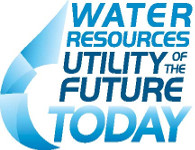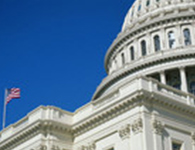Utility of the Future Today Recognition Recipients Announced
 NACWA, along with the Water Environment Federation (WEF), Water Environment & Reuse Foundation (WE&RF), and WaterReuse, has announced the recipients of the inaugural Utility of the Future (UOTF) Today recognition program. The 61 recipients
NACWA, along with the Water Environment Federation (WEF), Water Environment & Reuse Foundation (WE&RF), and WaterReuse, has announced the recipients of the inaugural Utility of the Future (UOTF) Today recognition program. The 61 recipients  represent a diverse array of public and private utilities from across the United States, Canada, and Denmark. Each of the recipients is bound by a shared commitment to integrating UOTF principles into their organizations.
represent a diverse array of public and private utilities from across the United States, Canada, and Denmark. Each of the recipients is bound by a shared commitment to integrating UOTF principles into their organizations.
The UOTF initiative began in 2013 to promote wastewater utilities transition toward smarter, more efficient practices. The UOTF Today program recognizes the progress made by the utilities to implement innovative technologies and to champion a culture of change. As the UOTF brand grows, “this recognition will inspire the sector as a whole to achieve still untapped economic and environmental benefits,” said NACWA CEO, Adam Krantz. The recipients will be honored at a ceremony during the Utility Leaders Morning on Tuesday, September 27 at WEFTEC 2016.
Sector Groups, EPA Discuss Water Quality Trading, Utility Financing
 NACWA and representatives from other water sector associations, including the National Association of Water Companies (NAWC) and the Water Research Foundation (WRF), discussed a range of issues last week with Ellen Gilinsky, EPA Office of Water Senior Policy Advisor, and other senior staff during a bi-monthly meeting. EPA discussed its collaborative efforts with the U.S. Department of Agriculture (USDA) to support water quality trading and encourage more programs nationwide. In a recent blog, the Agency and USDA summarized a report from a September 2015 National Workshop on Water Quality Markets and the plan for action that both agencies will undertake to promote water quality trading, including a national database of trading programs (see related article this issue).
NACWA and representatives from other water sector associations, including the National Association of Water Companies (NAWC) and the Water Research Foundation (WRF), discussed a range of issues last week with Ellen Gilinsky, EPA Office of Water Senior Policy Advisor, and other senior staff during a bi-monthly meeting. EPA discussed its collaborative efforts with the U.S. Department of Agriculture (USDA) to support water quality trading and encourage more programs nationwide. In a recent blog, the Agency and USDA summarized a report from a September 2015 National Workshop on Water Quality Markets and the plan for action that both agencies will undertake to promote water quality trading, including a national database of trading programs (see related article this issue).
EPA also provided a summary of the July 19 program on funding and financing water infrastructure for communities in need, which several NACWA members participated in. As a follow-up to this event, the Agency will provide additional information to utilities and communities, share successful funding mechanisms, and facilitate communication between utilities about financing challenges and solutions.
EPA also provided an overview of its recently updated Climate Resilience Evaluation & Awareness Tool (CREAT), which assists water, wastewater and stormwater utilities in their climate risk assessment and planning (see related article this issue). NACWA plans to assist EPA with populating the tool with adaptation case studies from utilities nationwide. The Association will provide more information to members on this tool in the near future.
NACWA Active on Swimming Pool Discharges
 EPA is currently completing its review of a swimming pool biocide, lithium hypochlorite, which is the first swimming pool chemical under evaluation in the Agency’s current round of pesticide reviews. Since wastewater and stormwater utilities have expressed concerns about the potential of fish kills due to the chemicals in swimming pool discharges, the Agency has proposed label language for lithium hypochlorite that would require contacting the local utilities and following their discharge instructions.
EPA is currently completing its review of a swimming pool biocide, lithium hypochlorite, which is the first swimming pool chemical under evaluation in the Agency’s current round of pesticide reviews. Since wastewater and stormwater utilities have expressed concerns about the potential of fish kills due to the chemicals in swimming pool discharges, the Agency has proposed label language for lithium hypochlorite that would require contacting the local utilities and following their discharge instructions.
The final language for lithium hypochlorite labels is expected to set a precedent for other swimming pool chemicals. NACWA will coordinate with its Pretreatment & Pollution Prevention Committee to submit comments on the label language by the September 12 deadline.
NACWA Considers Prospects for WRDA
 Congress left for summer recess without either chamber passing a 2016 Water Resources Development Act (WRDA) bill. Both the Senate and House passed bills out of committee, but they await floor time when Congress returns in the fall. NACWA continues to engage with key Congressional offices to encourage passage of the bill, as the bill presents an opportunity to get several key clean water provisions signed into law. The Association anticipates that the Senate will move first to pass the bill, potentially as early as the second or third week of the September Congressional session. If the House takes up its bill, it is more likely to occur during a lame duck session after the November election. NACWA has posted WRDA resources and encourages members to reach out to their Congressional delegations in support of the bill. Contact NACWA Legislative Affairs Manager,
Kristina SurfusThis e-mail address is being protected from spambots. You need JavaScript enabled to view it
with any questions on WRDA.
Congress left for summer recess without either chamber passing a 2016 Water Resources Development Act (WRDA) bill. Both the Senate and House passed bills out of committee, but they await floor time when Congress returns in the fall. NACWA continues to engage with key Congressional offices to encourage passage of the bill, as the bill presents an opportunity to get several key clean water provisions signed into law. The Association anticipates that the Senate will move first to pass the bill, potentially as early as the second or third week of the September Congressional session. If the House takes up its bill, it is more likely to occur during a lame duck session after the November election. NACWA has posted WRDA resources and encourages members to reach out to their Congressional delegations in support of the bill. Contact NACWA Legislative Affairs Manager,
Kristina SurfusThis e-mail address is being protected from spambots. You need JavaScript enabled to view it
with any questions on WRDA.
EPA, USDA Affirm Collaboration on Water Quality Trading
 In a recent blog co-authored by Ann Mills, USDA Deputy Under Secretary for Natural Resources & Environment, and Ellen Gilinsky, EPA Office of Water Senior Policy Advisor, the two agencies highlight their collaborative actions to support the expansion of water quality trading nationwide. The blog also links to a EPA-USDA report
In a recent blog co-authored by Ann Mills, USDA Deputy Under Secretary for Natural Resources & Environment, and Ellen Gilinsky, EPA Office of Water Senior Policy Advisor, the two agencies highlight their collaborative actions to support the expansion of water quality trading nationwide. The blog also links to a EPA-USDA report  published in June that summarizes the September 2015 National Workshop on Water Quality Markets held in Lincoln, Nebraska, and future directions for USDA-EPA efforts. NACWA staff participated in the Workshop last fall.
published in June that summarizes the September 2015 National Workshop on Water Quality Markets held in Lincoln, Nebraska, and future directions for USDA-EPA efforts. NACWA staff participated in the Workshop last fall.
The report and blog come on the heels of a highly negative report  from the environmental activist group Food & Water Watch on water quality trading and market-based environmental approaches overall. In response, the National Water Quality Trading Alliance, of which NACWA is a member, published an article making the case for water quality trading. Contact NACWA Legislative Affairs Manager,
Kristina SurfusThis e-mail address is being protected from spambots. You need JavaScript enabled to view it
, for more information.
from the environmental activist group Food & Water Watch on water quality trading and market-based environmental approaches overall. In response, the National Water Quality Trading Alliance, of which NACWA is a member, published an article making the case for water quality trading. Contact NACWA Legislative Affairs Manager,
Kristina SurfusThis e-mail address is being protected from spambots. You need JavaScript enabled to view it
, for more information.
EPA Releases Updated Resilience Tools for Utilities
 EPA has launched an updated version of their Climate Resilience Evaluation & Awareness Tool (CREAT,) which assists water, wastewater and stormwater utilities in their climate risk assessment and planning.
EPA has launched an updated version of their Climate Resilience Evaluation & Awareness Tool (CREAT,) which assists water, wastewater and stormwater utilities in their climate risk assessment and planning.
CREAT 3.0 updates CREAT 2.0 used by many NACWA members during their vulnerability assessments and other long-term planning. The new tool has an improved web-based interface and adds features like a risk assessment report that includes complete monetization. Input from practitioners, associations, and climate scientists have all helped to make this a more robust tool for clean water utilities to understand and adapt to climate change.
CREAT 3.0 is offered through EPA’s Climate Ready Water Utilities (CRWU) initiative which also includes the recently released Adaptation Case Study & Information Exchange interactive map to give water sector utilities a platform to explore real-world case studies of utilities across the U.S. that are addressing climate threats. The tool also encourages utilities to submit their own adaptation case studies and connect with one another for information on how their communities can pursue similar adaptation strategies. As the water sector continues to implement climate adaptation measures, sharing best practices and lessons learned can help inform the adaptation planning and decision making processes of other utilities.
Water as a Women's Issue Highlighted in TEDx Talk
 For most Americans, access to clean water has become so commonplace, it is difficult to imagine life without water in our daily routines. For an estimated third of the world’s population, however, this level of access is unfathomable.
For most Americans, access to clean water has become so commonplace, it is difficult to imagine life without water in our daily routines. For an estimated third of the world’s population, however, this level of access is unfathomable.
Eleanor Allen, Chief Executive Officer of Water for People, envisions a different future; one where all people have access to clean water, as well as taps and toilets. According to Allen, this burden also falls disproportionately upon women in developing countries, who must often make miles-long treks to get water each day. In her TEDx Talk Allen outlines how this issue can be addressed by 2030 through investment and international collaboration.
As a strong support of Water for People, NACWA believes that Allen’s TEDx Talk not only raises the dire issue of clean water access around the world, but also serves as a reminder of how fortunate we are in the United States.
Upcoming UOTF Webinar Focuses on Resilience
 NACWA Member Agencies the Albuquerque Bernalillo County Water Utility Authority (ABCWA) and the Narragansett Bay Commission (NBC) will share their strategies for addressing challenges brought about by climate change on September 14 during the
NACWA Member Agencies the Albuquerque Bernalillo County Water Utility Authority (ABCWA) and the Narragansett Bay Commission (NBC) will share their strategies for addressing challenges brought about by climate change on September 14 during the  Building a Resilient Utility of the Future webinar.
Building a Resilient Utility of the Future webinar.
ABCWA is finalizing their WATER 2120: Securing Our Water Future plan to ensure adequate water resources in the face of long-term drought, while in Rhode Island, NBC often experiences the opposite problem: dealing with too much water and rising sea levels. This is the third installment in the Enabling the Water Resources UOTF webinar series offered by EPA, NACWA, WEF, and WE&RF in 2016 to highlight how utility managers are optimizing their efficiency, recovering valuable resources and contributing to the overall health of watersheds.
Garden City Disconnects All City-Owned MS4 Outfalls with Green Infrastructure
 Garden City, Idaho is leading the way in environmental responsibility by looking at stormwater runoff unconventionally. Since July 2015, Garden City has disconnected all city owned MS4 (Municipal Separate Storm Sewer System) conveyance structures and no longer discharges stormwater into local rivers.
Garden City, Idaho is leading the way in environmental responsibility by looking at stormwater runoff unconventionally. Since July 2015, Garden City has disconnected all city owned MS4 (Municipal Separate Storm Sewer System) conveyance structures and no longer discharges stormwater into local rivers.
Garden City is the first in the country to take this approach to limit discharge of urban runoff into local waterways. The City replaced its outdated stormwater drainage system that used to flow into the Boise River with two shallow storage/infiltration swales. Swales slow down and filter runoff which increases groundwater recharge and provides additional water for vegetation.
This cost-effective, sustainable infrastructure is pleasant to look at, provides environmental benefits and meets the City’s regulatory requirements. “Garden City actively promotes on-site stormwater retention and feels the best way to demonstrate this is to lead by example,” says Colin Schmidt, Garden City Public Works Director.